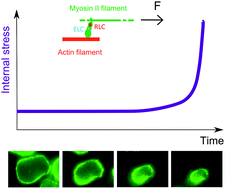Contraction speed of the actomyosin cytoskeleton in the absence of the cell membrane†
Abstract
The contraction of the actomyosin cytoskeleton, which is produced by the sliding of myosin II along actin filaments, drives important cellular activities such as cytokinesis and cell migration. To explain the contraction velocities observed in such physiological processes, we have studied the contraction of intact cytoskeletons of Dictyostelium discoideum cells after removing the plasma membrane using Triton X-100. The technique developed in this work allows for the quantitative measurement of contraction rates of individual cytoskeletons. The relationship of the contraction rates with forces was analyzed using three different myosins with different in vitro sliding velocities. The cytoskeletons containing these myosins were always contractile and the contraction rate was correlated with the sliding velocity of the myosins. However, the values of the contraction rate were two to three orders of magnitude slower than expected from the in vitro sliding velocities of the myosins, presumably due to internal and external resistive forces. The contraction process also depended on actin cross-linking


 Please wait while we load your content...
Please wait while we load your content...